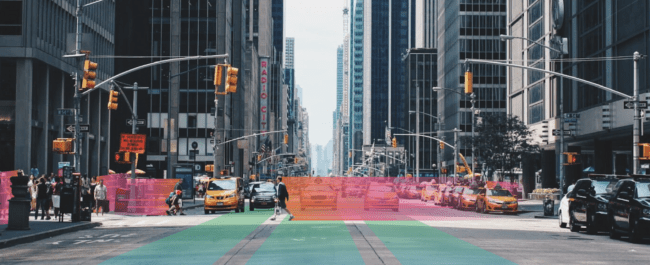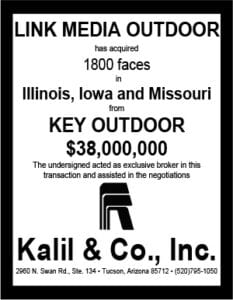
From Adkom on LinkedIn
Out-of-home advertising is back stronger than ever, thanks in part to the pandemic. COVID-19 has accelerated several trends that have been building up for years, bringing them into the mainstream, and in the process has created the perfect environment to leverage OOH for improved results.
The Trends: Where Your Clients’ Customers Will Be In 2022
Remote work means fewer people travel to city centers. Inrix data shows a 22% decline in downtown visitors (up to 40% in heavily impacted cities). Public transit has dropped almost in half, as commuters think a personal vehicle is safer.
Residents in larger cities are staying close to home. There are moves in many medium and large cities to shift street space to exclusively pedestrian usage as well as to invest in cycling infrastructure, reflecting this shift to more localized activity.
Despite these shifts within cities, travel across the board (urban, suburban, and rural) is slowly making its way back towards 2019 levels. Traffic patterns have shifted, however; vehicle traffic is more spread out into the afternoon as fewer people are commuting to work in the morning, and foot traffic has moved from mornings to evenings and weekends.
Expected travel for 2022 is up: a Harris Poll/OAAA study reports that 78% of workers expect to commute part time or more, up 7% since last year.. Seventy-eight percent of people expect to travel for vacation in the first half of 2022, while travel patterns for 43% of the population will be similar to or greater than pre-COVID.
In summary, city consumers are staying close to home, in a radius of where they can walk or bike. Outside of cities, people still prefer cars over other transport, and travel volume is approaching 2019 numbers. In both cases, OOH offers a unique avenue to grab attention while consumers are on the move; the key is leveraging the full array of OOH options to reach consumers exactly where they are.
The Outdoor Advantage: Getting More for Client Ad Budgets
Why outdoor? First, OOH advertising revenue increased 38% (with digital out-of-home revenue specifically increasing by 56%), to $1.75 billion, just in the third quarter of 2021 (compared to Q3 2020). Top OOH advertisers have ratcheted up spend over 2020, in some cases as much as 10-fold. The point? Your clients’ competitors are in OOH, and they’re appreciating the investment.
Second, digital device burnout is driving consumer behavior: an OAAA/On device research report finds that 71% of respondents reported tuning out digital device ads; 68% were increasingly concerned with privacy and security when shopping online; and 47% would like to reduce phone, computer, and/or TV usage after months of spending all their time on devices while at home. Around 75% of consumers are trying to get out of the house more and are looking for safe outdoor activities to spend their time on.
Third, OOH has sparked renewed interest from people post-pandemic, with attention, interest, and engagement up over pre-COVID. The survey cited above reports that 70% of respondents are more appreciative and aware of their outdoor surroundings following the lifting of pandemic restrictions, while 53% are noticing OOH ads more than before COVID.
Eighty-five percent of those who have noticed OOH ads find them useful, and roughly half of those who notice them are more likely to visit the retailer’s online or physical store (55% and 48%, respectively). Apart from COVID-19 information, the top five most useful outdoor ads include special offers and promotions, awareness of a new business or service, and advertiser information, such as hours, services, website/social media, and directions to the business.
The top three actions of the 57% of people who have engaged with OOH ads are visiting the advertiser’s website, searching for more information about the advertiser or their products, and making a physical purchase.
Going Outside Meets Consumers Where They Are, Generates Greater Interest and Engagement, and Boosts Sales
Your clients have more options to reach their audiences than ever before:
- Digital/programmatic offers good targeting, but little attention and engagement
- Broadcast TV is great for reaching a mass audience with an emotionally compelling audio/visual experience, but that audience is shrinking and is paying a decreasing amount of attention to advertising)
- Search/social hits consumers where they are, but faces vast competition for an increasingly limited share of voice, and faces steadily rising prices
Out-of-home, especially digital out-of-home, fills a void left by other media. It grabs attention, raises awareness, and drives engagement and action in a way often missing elsewhere. But, as with all things in marketing, its true strength comes from integration in an omnichannel campaign.
DOOH paired with broadcast will increase brand awareness faster than either medium by itself. It can activate consumers to research a business or product, integrating well with a search strategy. It increases awareness and engagement with social, making that channel work much harder for your client. Geofencing around your outdoor ads can increase your impression share and click-through rates in display and social advertising.
Adkom can offer you impactful media, scale, and flexibility that almost no other vendor can match. Our approach to connecting independent media owners to media planners and buyers allows us to offer you outdoor media in a wide range of formats across prime locations. This flexibility lets you hit consumers at any point of transit, from highways to city neighborhoods. We make out-of-home campaign activation as easy as any social media or programmatic campaign, providing versatility unavailable from traditional OOH vendors.
Get in touch with Adkom today to see if DOOH makes sense for your clients’ 2022 ad campaigns.
[wpforms id=”9787″]
Paid Advertisement
















